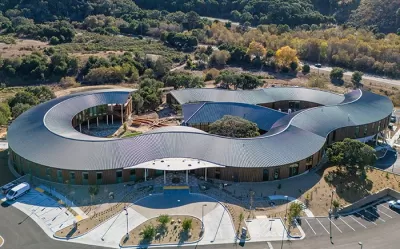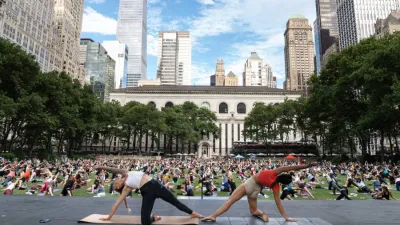Far from the drab and claustrophobic mental health facilities of cinematic fame, Ohana aims to serve patients in an aesthetically soothing, nature-driven environment.

In a piece for Bloomberg CityLab, Alexandra Lange describes a mental health facility in Monterey, California designed with youth in mind, one that uses mass timber and soft furniture to create a comforting, open, and light-filled space that bucks the stereotype of the sterile, brutalist mental health ward.
The overall aesthetic of Ohana could be described as 21st century prep school, except here youth are not molded into cookie-cutter members of the elite but provided with the tools to mold themselves. Instead of long, straight, whitewashed hallways, there are curved, sunlit, wood-framed corridors. Instead of being surmounted by a timekeeping belltower, the highest point is the eyebrow curve of the lobby roofline, supported by visible glue-laminated timber beams and columns, directing the gaze out to the hills and up to the sky.
The facility also features expansive hillside views from its south-facing rooms and art selected to appeal to young viewers. “Outside, on the terrace, raised beds will soon be absorbed into the clinic’s programming via a garden club, while the rest of the landscaping, designed by Monterey firm BFS Landscape Architects, emphasizes plants like mint, lavender, and rosemary, whose bioactive phenols can activate the immune system and help with sleep.”
The facility works with health insurance and is funded in part by a $60 million endowment. Executive director Susan Swick hopes it can serve as a model for this type of care and offer evidence that it can achieve better outcomes for patients. “While Swick and her team collect data, Ohana is already making a statement, materially, that mental health care should not be secret, that better care is found in community, and that children deserve the best design.”
FULL STORY: How Design Promotes Better Mental Health for Children

Maui's Vacation Rental Debate Turns Ugly
Verbal attacks, misinformation campaigns and fistfights plague a high-stakes debate to convert thousands of vacation rentals into long-term housing.

Planetizen Federal Action Tracker
A weekly monitor of how Trump’s orders and actions are impacting planners and planning in America.

San Francisco Suspends Traffic Calming Amidst Record Deaths
Citing “a challenging fiscal landscape,” the city will cease the program on the heels of 42 traffic deaths, including 24 pedestrians.

Defunct Pittsburgh Power Plant to Become Residential Tower
A decommissioned steam heat plant will be redeveloped into almost 100 affordable housing units.

Trump Prompts Restructuring of Transportation Research Board in “Unprecedented Overreach”
The TRB has eliminated more than half of its committees including those focused on climate, equity, and cities.

Amtrak Rolls Out New Orleans to Alabama “Mardi Gras” Train
The new service will operate morning and evening departures between Mobile and New Orleans.
Urban Design for Planners 1: Software Tools
This six-course series explores essential urban design concepts using open source software and equips planners with the tools they need to participate fully in the urban design process.
Planning for Universal Design
Learn the tools for implementing Universal Design in planning regulations.
Heyer Gruel & Associates PA
JM Goldson LLC
Custer County Colorado
City of Camden Redevelopment Agency
City of Astoria
Transportation Research & Education Center (TREC) at Portland State University
Jefferson Parish Government
Camden Redevelopment Agency
City of Claremont





























